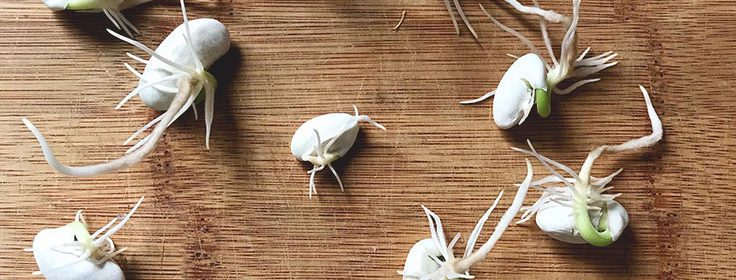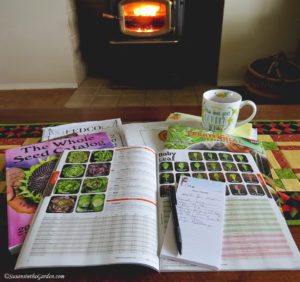Jan. 5 Column: Seed Catalogs

It’s time for my next monthly garden column! This one is about seed viability (the shelf life of seeds) and some of my favorite seed catalogs. You can read it in today’s edition of The Spokesman-Review: ‘Tis the season to prepare. (or you can read my column lower in this post)
Oh how I love looking at new seed catalogs!
The seed catalogs have been rolling in steadily, which sure makes it hard for me to make my choices. Once Bill has decided which pepper varieties he’d like to grow this year, we can put in our orders. And you’ll be happy to hear that I’ll publish a list of all of the veggies we’ll be growing both on this website and with my first weekly column of the season, which will run on Sunday, Feb. 23. You’ll be able to find the online list under the “Guides” menu; just look for Susan’s Garden – 2020. It’s not complete yet, though, so bear with me!
I also have a new video for you to watch. This one is on “Indoor Gardening in Winter.” As you’ll see, there are plenty of garden-related things to do this time of year. And you’ll be happy to hear that Bill helped me shell the rest of the bean pods! (this will make sense once you see the video, LOL) Thanks, honey.
Seed catalogs garden column:
by Susan Mulvihill
Now that the holiday season is behind us, gardeners can focus their attention on planning this year’s garden. If you’re like me, you’ve had a steady stream of catalogs arriving in your mailbox. Now is the perfect time to find out what’s new while taking stock of what’s left of your seed collection from last year.
Seed viability
The average shelf life for vegetable seeds is listed in the information box. It refers to the period of time when you can expect good germination (sprouting) rates. These are general guidelines since some seeds are viable for a lot longer than we give them credit for.
There is an easy way to test older seeds. Place 10 seeds from a packet onto a moistened paper towel. Fold the towel around them and set inside a plastic bag. Refer to the seed packet for the typical days to germination and check on the seeds every few days.
Count how many have sprouted. If all 10 have, that is a 100-percent germination rate. It’s 40 percent if only 4 have. If the germination rate is 50 percent or lower, you have two options. Consider replacing those seeds or sow the seeds more thickly than the seed packet recommends. You might need to thin the extra seedlings to space the plants appropriately, but at least you didn’t let the seed packet go to waste.
Susan’s favorite seed catalogs
If you are in the market for new seeds, check with your local independent garden center first. This allows you to study the packets in person and save on shipping costs.
Seed catalogs are great fun to look through, whether in print form or online. Here are some of my favorites:
Baker Creek Heirloom Seeds (rareseeds.com) _ Their catalogs are filled with a wide variety of unusual or hard-to-find seeds. Each year, Baker Creek also publishes their hefty “Whole Seed Catalog” which you can find in bookstores and on newsstands; this year’s issue is a whopping 450 pages. They no longer charge shipping fees for orders.
Ed Hume Seeds (humeseeds.com) _ This company is based in Puyallup, Wash., and founded by garden guru Ed Hume over 40 years ago. It’s always a good option to select seeds offered by regional suppliers. Their seed catalog is online only but each seed packet links to detailed cultural information and tips based on Hume’s vast experience. Ed Hume Seeds can also be found in garden and home centers.
Fedco Seeds (fedcoseeds.com) _ Based in Maine, Fedco has been in business for 42 years. They offer all types of seeds (even for cover crops and grains), seed potatoes, soil amendments, natural insect controls, tools and books. While this catalog is in black and white, the illustrations — which are reminiscent of the “Fearless Flyer” newsletters from Trader Joe’s — and fun descriptions more than make up for it.
High Mowing Organic Seeds (highmowingseeds.com) _ This company sells organic vegetable, flower and herb seeds as well as seeds for sprouting or growing microgreens. They offer seeds in different quantities to meet growers’ needs and there’s no shipping charge for orders over $10.
Johnny’s Selected Seeds (johnnyseeds.com) _ Johnny’s catalogs contain so much cultural information for growing all crops, they could easily double as a gardening reference book. They also sell seed-starting supplies and tools and have how-to videos on their website.
Renee’s Garden Seeds (reneesgarden.com) _ While the catalog is online-only, the often unique or hard-to-find offerings of vegetable, flower and herb seeds are carried in many garden centers as well. Renee’s Garden also stocks seed potatoes and shallots.
Seed Savers Exchange (seedsavers.org) _ Since 1975, this non-profit organization has dedicated their efforts to saving and sharing America’s heirloom, open-pollinated seeds. You can shop from their seed catalog or become a member to help support this marvelous program and participate in seed swaps with other members.
Territorial Seed Company (territorialseed.com) _ A Northwest seed source, Territorial is based in Cottage Grove, Ore. and has been family owned since 1979. They offer vegetable, herb, flower and microgreen seeds in multiple quantities. They have a flat shipping rate of $7.95 for all orders.
One last thing: gardeners naturally tend to be wary of the potential for being sold seeds from genetically-modified crops. It’s important to understand that these types of seeds are not marketed to home gardeners. All garden seed suppliers have signed the Safe Seed Pledge indicating they will never knowingly sell genetically-modified seeds.
Susan Mulvihill is co-author, with Pat Munts, of “Northwest Gardener’s Handbook.” Contact her at Susan@susansinthegarden.com. Watch this week’s “Everyone Can Grow a Garden” video on youtube.com/c/SusansintheGarden.
Vegetable seed viability
The following list shows the typical shelf life of vegetable seeds:
One year: Leeks, onions, parsnips
Two years: Corn, okra, peppers
Three years: Arugula, beans, broccoli, carrots, peas, spinach
Four years: Beets, Brussels sprouts, cabbage, cauliflower, chard, eggplant, kale, kohlrabi, mustard, pumpkins, rutabagas, summer squash, tomatoes, watermelon, winter squash
Five years: Artichokes, celery, collards, cucumbers, endive, lettuce, melons, radishes, turnips

